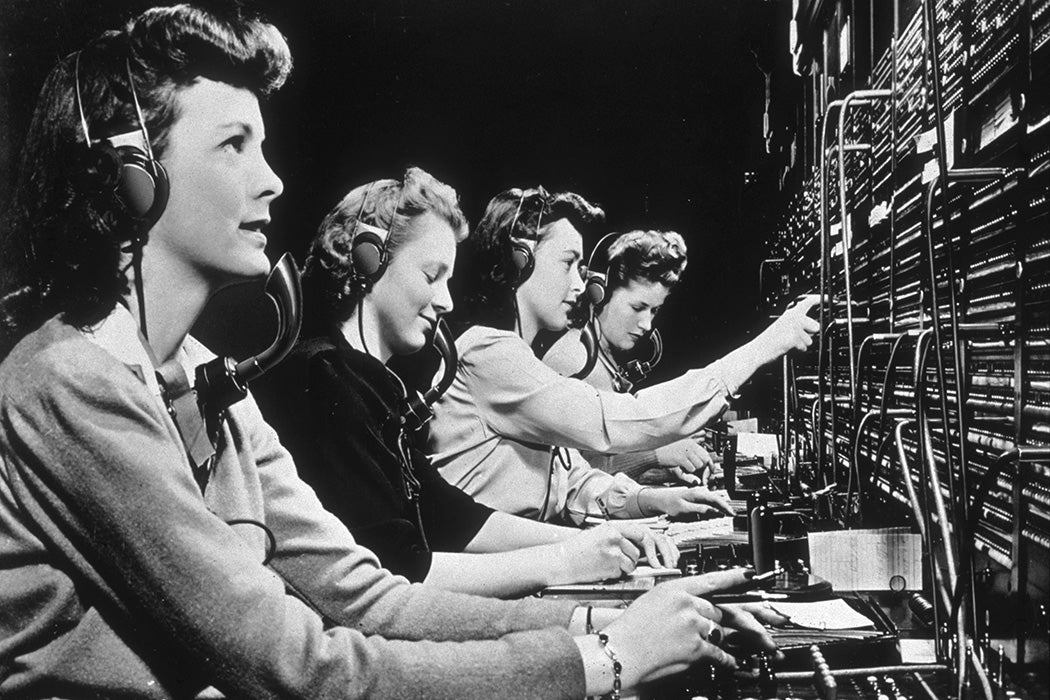The phrase “women and telephones” typically conjures sexist images. Search on Google and you’ll learn that women, it seems, love to gab; heads atilt, hair in rollers, mouths agape mid-sentence.
Historically, however, women were the driving force behind telephony in a completely different, albeit invisible manner: they were switchboard operators, manually answering incoming calls and connecting them with intended recipients by plugging a cable into a switchboard. It was a crucial job and one with widespread social ramifications. As Milton Mueller notes in a 1989 article, telephones were “collapsing” our “social space” and expanded its scale by “making millions of people who would otherwise be inaccessible to each other capable of instant, real-time conversation.”
Initially the work of connecting calls went to teenage boys, notes Robert E. MacKay in his review of Stephen H. Norwood’s Labor’s Flaming Youth: Telephone Operators and Worker Militancy, 1878-1923. It wasn’t until “customer service became of ever greater concern to management,” writes MacKay, that “boys were replaced with young women, and telephone operating became ‘women’s work.’”
Boys, Joan Sangster writes in a 1978 article, were, quite simply, considered impolite and, at least by the Canada-based Bell Telephone company, “not as conscientious and patient as women.” Indeed, by 1900, Bell Telephone demanded that their operators—all women—be “physically fit in order to tackle the exacting work at the switchboard.” Applicants had to be sufficiently tall that they could reach top wires, prove they had good hearing and eyesight, and “could not wear eyeglasses or have a consumptive cough.”
South of the border, in the United States, women similarly came to dominate the profession. In the early 1900s, they accounted for eighty percent of all telephone operators in the US. By the time World War I began, bilingual American women served in the American Expeditionary Forces (AEF) as telephone operators—helping army personnel follow the evolving situation and interacting with Allied units across France. Known as the “Hello Girls,” these women waited until 1979 to be recognized finally as veterans. The Hello Girls were the subject of Elizabeth Cobbs’ book of the same name and, suggests Jill Frahm in her review of the book, paved the way for American suffragists.
Yet wartime wasn’t the only time the work of switchboard operators went unrewarded. Due to exemptions under the Equal Pay Act of 1963, “any switchboard operator employed by an independently owned public telephone company which [had] not more than seven hundred and fifty stations” did not receive the same wages as her male counterpart.
What’s more, the widespread and growing popularity of telephones meant telephone companies needed to hire more operators and improve their technology.
Initially, this upgrade came in the form of automatic dialing, tech that allowed callers to reach other each other directly. Invented in 1889 by Almon B. Strowger, a Kansas City funeral director who set out to establish a “girl-less, cuss-less telephone,” automatic dialing ushered in the era of rotary phones.
As this technology spread, the need for switchboard operators faded, especially in the face of the development of improved transoceanic cable and the eventual rise of the transistor. By the 1960s, operators were largely facilitators of calls that didn’t go through automatically.
In “Race and Technology: African American Women in the Bell System, 1945-1980,” Venus Green quotes switchboard operators describing how demoralized they felt as their work became obsolete. With the advent of new technology that came to be known as Traffic Service Position (TSP), one worker remarked, “the customer was in your ear,” from the get-go. Overnight, switchboard operators went from entirely essential to wholly optional; instead of connecting calls via cords, they now pushed buttons.
Eventually, TSPs evolved to measure automatically the length of time an operator spent on a call and how many calls she handled. They eliminated the need for operator input in determining call routing and automatically calculated charges— fees an operator formerly would have had to calculate by hand.
Weekly Newsletter
Owing to wages that were often below anti-discrimination thresholds and the presumption of a “skill gap”—where increased automation meant a supposed decrease in skill required—Green demonstrates how “women’s jobs” shifted from being jobs for white women to jobs for Black women and other women of color. “[While] Black operators in the larger cities replaced white operators,” writes Green, “the push to automate” resulted in an unfairly small window of opportunity for Black women. “In effect,” writes Green, “as soon as the job opportunity opened for large numbers of African American women, the introduction of high-speed computerized equipment closed it.”
By the 1970s, technological advancements had phased out cord switchboards entirely. And in 1983, in Bryant Pond, Maine, America’s last hand-cranked telephone system and the switchboards operated by one Susan Glines were finally retired.







